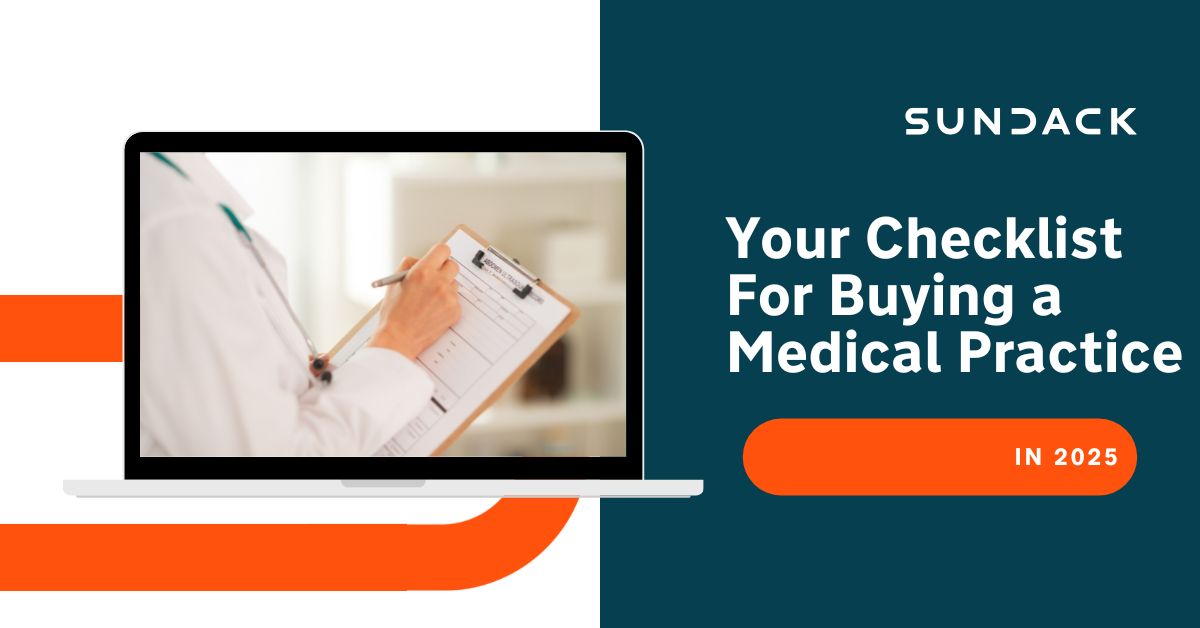Buying a medical practice can feel a lot like buying a house you want to transform into your dream home. You’re not just looking at the price tag or the overall design—you’re also thinking about the foundation, the neighborhood, and how it fits into your long-term lifestyle.
In the same way, when you’re buying a medical practice, there are many angles to consider—financial, strategic, and operational. These factors will be the pillars of your practice, making sure what you buy today aligns with your long-term goals and vision for the future.
If this is your first time buying a medical practice, here’s a checklist to guide you and help you avoid costly regrets down the road.
Financial Factors
The financial health of a medical practice is one of the most important factors to consider. After all, you don’t want to buy a practice that’s already sinking, right?
Here’s what to focus on:
Financial Position and Performance
Start by reviewing five years of financial statements. Have an experienced medical CPA go over them with you to ensure everything checks out. Examine the tax returns—are they making decent profits? How’s the cash flow? Are revenues trending up, down, or staying flat? Are there any red flags on the P&L that the seller might be trying to hide? This is where the guidance of an experienced medical CPA is invaluable.
Example: Let’s say the practice’s cash flow has been steady, but profits are dipping. That could be a sign of rising costs, a shrinking patient base, or both. You’ll need to assess whether you can turn that trend around before jumping in.
Cost Structure
In the medical field, overhead costs can be steep. Look closely at fixed expenses like rent, salaries, and utilities. These costs will be your responsibility once you take over, so think about whether there are ways to minimize them.
Example: If the practice is paying an above-market rent for a prime location, is it worth it for the patient flow? Could you potentially negotiate a better lease?
Debts and Liabilities
Is the practice operating at a healthy debt ratio, or is it drowning in debt? Buying a practice that’s deep in debt can be a red flag. However, if you believe you can turn things around, you may be able to assume those debts and negotiate a debt restructuring agreement. Keep in mind that purchasing a practice with significant debt can be risky, so we recommend assessing this based on your risk tolerance.
Strategic Factors
When we talk about strategic factors, we’re focusing on the “big picture,” like planning 10 to 15 years into the future. If you’re considering buying a medical practice, it can be difficult to think long-term, especially because strategic factors are primarily qualitative. While financial data provides clear numbers, strategic thinking involves projections and forecasts that are less certain.
The key question is how this practice fits into your long-term vision. What value does it bring to your future plans?
To help guide your big-picture thinking, here are a few important points to consider:
Market Positioning
How is the market where the medical practice operates? Don’t just focus on the physical location—think broader. Is this practice the go-to provider in the area? Is it the closest option for people within a 10 to 20-mile radius? What’s the community’s perception of the practice? Do they have a positive image of it, or is it the opposite? Market positioning is crucial because running a business in a weak market can be very challenging.
Competitive Landscape
How is the competition in the area? Are there multiple practices nearby, or are you directly competing with the one you’re looking to buy? Acquiring a competitor can reduce competition and increase your market share, but if that’s not the case, take a look at how other practices are operating. Are they offering additional services that enhance the patient experience? Are they more advanced or more popular?
Patient Base
What are the demographics of the area? Is the practice located in the suburbs or a city? Suburban areas often attract families, so having pediatricians and internists can help you serve both newborns and adults. However, you also need to assess demand. Look at population trends over the past six to eight years. Is it steadily growing or declining? What’s the median age? Understanding the median age will help you align your services with the community’s healthcare needs.
Operational Factors
Finally, operational factors look at the day-to-day aspects of the practice. It involves the workflows, processes, and overall productivity of the practice.
Here are some things to consider:
Billing and Collections Efficiency
How quickly does the practice get paid for its services? Slow billing and collections can drag down cash flow.
Example: If the practice has a lot of outstanding bills that are 90+ days overdue, that’s a red flag. You’ll need to improve the billing process to ensure you’re getting paid on time.
Technology and Equipment
Take a look at the equipment and technology in use. Is it up to date? Will you need to make major investments to modernize it?
Example: If the practice is still using paper records, you’ll want to invest in electronic health records (EHR) software to improve efficiency. And if the X-ray machine is 10 years old, you may need to budget for an upgrade.
Need Expert Help Before Buying a Medical Practice?
Buying a medical practice is a big decision, but you don’t have to go through it alone. Sundack CPA is here to guide you every step of the way. We’ll evaluate the financials, operations, and long-term strategy to ensure the practice is a perfect fit for your goals.
After the acquisition, we’ll manage your taxes and books so you can focus on delivering top-quality care.
Ready to take the next step? Simply book a quick introductory call using our calendar to see how we can help.
Until next time!

